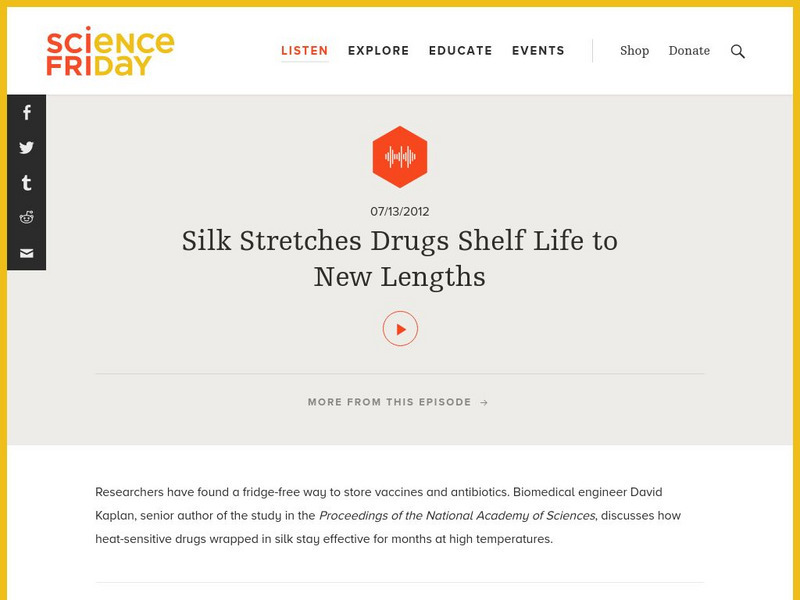Teach Engineering
Microfluidic Devices and Flow Rate
When you have to flow, you have to flow. The activity introduces class members to microfluidic devices and their uses in medicine. They watch a short video on how the diameter affects the rate of flow. The worksheet has individuals...
Teach Engineering
The Grand Challenge: Fix the Hip Challenge
It may be time to get to know the skeletons in your family. The first lesson in a series of 5, introduces the class to the concept of osteoporosis. The class members brainstorm possible causes and whether the family should be concerned...
Teach Engineering
Skin and the Effects of Ultraviolet Radiation
Though UV radiation can damage skin, it isn't all bad. The third installment in a six-part series allows the class to study the structure and function of skin. They learn about the different types of skin cancer and the SPF rating...
Teach Engineering
The Grand Challenge
Magnetic resonance imaging, just how safe is it? The introduction to unit study of magnetic resonance imaging technology presents the grand challenge questions of how an MRI machine works, the risks involved, the physics involved,...
Engenius Films
What is an Engineer?
So what is an engineer? An informative video provides a brief introduction to engineering. It shows what kids think an engineer is and what engineers think of the profession.
TED-Ed
Medicine's Future? There's an App for That
Imagine injecting tiny robots into your blood to help fight disease. According to Daniel Kraft, that's just one of many exciting new medical technologies coming our way in the not-so-distant future. The key to these amazing innovations...
Science for Kids
Science Kids: Technology Videos: Brain Machine Interface Video
See how a mind-controlled robot works. [3:32]
National Science Foundation
National Science Foundation: Giving Robots and Prostheses the Human Touch
Research engineers and students in the University of California, Los Angeles, Biomechatronics Lab are designing artificial limbs to be more sensational, with the emphasis on sensation. The team, led by mechanical engineer Veronica J....
Science Friday Initiative
Science Friday: Artificial Muscles Flex Using Fishing Line and Thread
Join the director of the NanoTech Institute as he shares details of the discovery of using sewing thread and fishing line to make artificial muscles.
Science Friday Initiative
Science Friday: Silk Stretches Drugs' Shelf Life to New Lengths
David Kaplan, a biomedical engineer, discusses his lab's research into how to store vaccines and antibiotics without refrigeration. Their method involves wrapping them in silk. It holds great promise for making these medicines more...
Science Friday Initiative
Science Friday: What the Doctor Ordered: Building New Body Parts
The science of regenerative medicine is developing methods for manufacturing new body parts such as organs, tissues, and muscles. Aired Sept. 21, 2012 [23:20 min]
National Science Foundation
National Science Foundation: Science of the Winter Olympic Games: Injury and Recovery
Biomedical engineer Cato Laurencin describes his pioneering work in tissue regeneration. His research looks at helping high performance athletes such as alpine ski racer Lindsey Vonn to recover faster from ligament damage in a knee...
Crash Course
Crash Course Engineering #6: Biomedical and Industrial Engineering
A video to study the history and fundamentals of industrial engineering, biomedical engineering, and bioengineering. [10:26]
PBS
Pbs Kids Design Squad: Artificial Liver
Dr. Howard Pryor develops an implantable device designed to help people suffering from liver disease. [1:04]
Science Friday Initiative
Science Friday: A Virtual Arm That Talks With the Brain
A virtual arm tested in monkeys is a step toward artificial limbs that communicate with the brain. [16:16]
Science Friday Initiative
Science Friday: Anticipating Synthetic Biology
As researchers draw nearer to the ability to design and grow new organisms from scratch, what planning and protections need to be in place to cope with the consequences?














